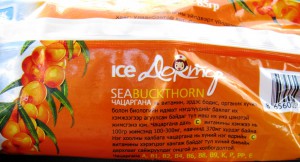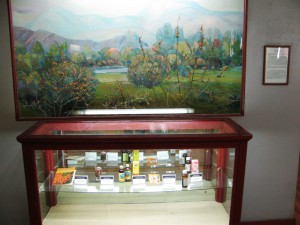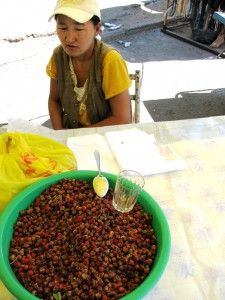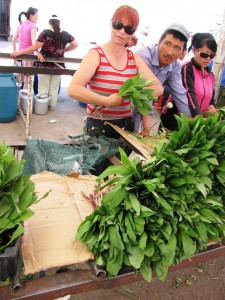- Mangofest in Miami. You missed it.
- Untreated seed saves bees? (Can someone please explain how this worked. If it worked.)
- Cary Fowler in the spotlight.
- IPCC envy? The Economist’s report on the Global Business of Biodiversity Symposium.
- “In seed time learn, in harvest time teach, in winter enjoy.”
- Ag experts descend on Ouagadougou for FARAweek. Hope springs eternal.
- Perennial sorghum?
Sea buckthorn becoming a success in a land with no sea
The name of the game in Mongolian agriculture is diversification. And one of the things researchers at PSARTI, the Plant Science Research and Training Institute in Darkhan, and others are looking at is a shrubby berry called sea buckthorn (Hippophae rhamnoides) with some interesting nutritional properties. They have put together a small germplasm collection of local and introduced material and are doing agronomic trials of various kinds, trying to find the best varieties for different purposes. In fact, the plant has a pretty long and rich history in Mongolia:
It is said that Genghis Khan, the Mongol conqueror, who established one of the largest empires from China to Eastern Europe in the 13th century, relied on three treasures: well organized armies, strict discipline and Seabuckthorn. Seabuckthorn berries and seed oil made Genghis Khan’s soldiers stronger than his enemies.
There are already some products on the market. Like this delicious icecream, called Ice Doctor.

The natural history museum in downtown Ulaanbaatar has a display featuring a number of locally-made products — a couple of different oils and “globules” — along with a somewhat threadbare diorama.

I guess commercialization still has some way to go, but a start has been made. Another wild species with some commercial potential may be strawberries.

Wild Allium of various kinds is also sold in the market.

Nibbles: Ecosystems, Coops, Cacao, Agroforestry
- Focus on ecosystem conservation: grasslands in South Africa, mangroves around the world.
- FAO says cooperatives are good for you.
- Great set of cacao photos from Sustainable Harvest International.
- Video Q&A on agroforestry with Dr Dennis Garrity, Director General of ICRAF.
The ups and downs of trees
I’m really not sure how good an idea it is, but this “Great Green Wall of Africa” that people are talking about will certainly be a sight to see. And a bit of a food resource too if the indicative list of the species that will be used is anything to go by. While I was wondering whether to write about this, four other tree-related stories popped up in my feed reader, which convinced me. So apparently “between 1980 and 1997 England saw a 64% drop in trees,” which sounds pretty incredible, but is probably nothing compared to what is going on in southern Congo. On the plus side, Argentina seem to be building its own green wall down south. Although there’s nothing in the press piece about what species will be used. And finally, in Liberia, old rubber trees are being uprooted and recycled, hopefully as a prelude to replanting something.
LATER: And another, from Tasmania.
Nibbles: Haitian mangoes, Dog bones, Vitis in Georgia, Lavandula in Tunisia, Pistacia in Chios, Rice wine in Korea, Nutella, Mozzarella, Gloucester Old Spot, Cowpea
- Buy Haiti’s Francis mangoes!
- The Muge dog was, in fact, a dog.
- Looking at the grapevine in its center of origin.
- Need to fence lavender populations in Tunisia to protect them.
- More Mediterranean stuff. History of the mastic trade in an Aegean island.
- Making “drunken rice” in Korea. Sign me up.
- Nutella to come with warning label? Jeremy says: We don’t need no nanny state!
- Bluish mozzarella balls confiscated. Jeremy says: Ok, maybe we do after all.
- EU makes itself useful and protects bacon pig of choice, with built-in apple sauce to boot.
- “…finding how the physical and chemical composition of different cowpea varieties influence human health, reduce obesity and prevent diseases like cancer, hypertension and heart related ailments.”